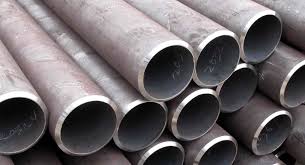
1. The main production process (main inspection process) of hot-rolled seamless pipe: tube blank preparation and inspection → tube blank heating → perforation → tube rolling → steel tube reheating → diameter (reduction) → heat treatment → finished tube straightening → finishing → Inspection (non-destructive, physical and chemical, Taiwan inspection) → warehousing
2. The main production process of cold-rolled (drawn) seamless pipe: Billet preparation→pickling lubrication→cold rolling (drawing)→heat treatment→straightening→finishing→inspection
The production process of general seamless pipe can be divided into two types: cold-drawing and hot-rolling. The production process of cold-rolled seamless pipe is generally more complicated than that of hot rolling. In the sizing test, if the surface does not respond to cracks, the round tube should be cut by a cutting machine and cut into a billet with a length of about one meter. Then enter the annealing process, annealing should be acid-washed with acid liquid. When pickling, pay attention to whether there is a lot of foaming on the surface. If there is a lot of foaming, it means that the quality of the steel pipe does not meet the corresponding standard. In appearance, the cold-rolled seamless pipe is shorter than the hot-rolled seamless pipe. The wall thickness of the cold-rolled seamless pipe is generally smaller than that of the hot-rolled seamless pipe, but the surface looks brighter than the thick-walled seamless pipe, and the surface is not too much. Much rougher, and the caliber doesn't have too many burrs.
The delivery state of hot-rolled seamless pipe is generally that the hot-rolled state is delivered after heat treatment. After the quality inspection, the hot-rolled seamless pipe must be strictly hand-selected by the staff. After the quality inspection, the surface should be oiled, followed by several cold-drawing experiments, and the perforation experiment should be carried out after the hot-rolling treatment. , If the perforation is too large, it will be straightened and corrected. After straightening, it is transferred to the flaw detector by the conveyor for flaw detection experiment, and finally labeled and arranged in specifications, and then placed in the warehouse.

Round tube blank→heating→piercing→three-roll skew rolling, continuous rolling or extrusion→tube removal→sizing (or reducing)→cooling→straightening→hydrostatic test (or flaw detection)→marking→warehousing
Seamless pipe is made of steel ingots or solid billets through perforation to make capillaries, which are then hot-rolled, cold-rolled or cold-drawn. The specifications of seamless pipe are expressed in millimeters of outer diameter and wall thickness.
The outer diameter of the hot-rolled seamless pipe is generally greater than 32mm, and the wall thickness is 2.5-200mm. The outer diameter of the cold-rolled seamless pipe can reach 6mm, and the wall thickness can reach 0.25mm. Rolling has higher dimensional accuracy than hot rolling.
General seamless pipe: It is made of high-quality carbon steel such as 10, 20, 30, 35, 45, low-alloy structural steel such as 16Mn, 5MnV, or 40Cr, 30CrMnSi, 45Mn2, 40MnB, etc. Seamless pipe made of low-carbon steel such as 10 and 20 is mainly used for fluid transportation pipelines. 45, 40Cr, and other medium carbon steel seamless pipe are used to manufacture mechanical parts, such as the stressed parts of automobiles and tractors. Generally, seamless pipe is used to ensure strength and flattening tests. Hot-rolled steel pipes are delivered in a hot-rolled state or heat-treated state; cold-rolled steel pipes are delivered in a heat-treated state.
Hot rolling, as the name implies, has a high temperature of the rolled piece, so the deformation resistance is small, and a large amount of deformation can be achieved. Taking the rolling of steel plate as an example, the thickness of continuous casting slab is generally about 230mm, and after rough rolling and finishing rolling, the final thickness is 1~20mm. At the same time, due to the small width-to-thickness ratio of the steel plate, the dimensional accuracy requirements are relatively low, and the plate shape problem is not easy to occur, and the main control is to control the crown. For those with organizational requirements, it is generally realized by controlled rolling and controlled cooling, that is, controlling the opening temperature and finishing temperature of finishing rolling. Round tube billet→heating→piercing→heading→annealing→pickling→oiling (copper plating)→multi-pass cold drawing (cold rolling)→blank tube→heat treatment→straightening→hydrostatic test (flaw detection)→marking→insertion library.